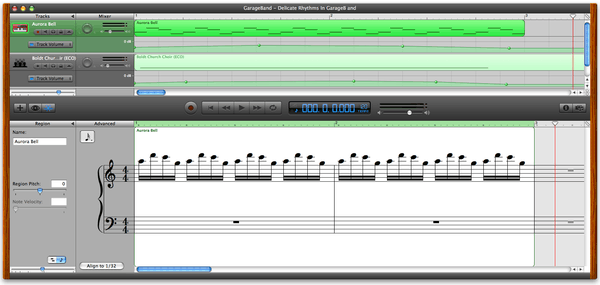|
Moods created from delicate rhythms
This lesson is all about repeating rhythms
- For this lesson, you create moods with very delicate rhythms. The music should sound like flowing water.
- Instructions for this exercise
- Select one instrument such as tiny bells or a harp.
- Create 6 seconds of rapidly repeating delicate rhythm using only four or five or six notes that repeat like flowing water.
- There can be slight variations but absolutely no melody. (These notes act like a chord, not a melody.)
- If you use a second instrument, it should be a single note in the background.
- Keep it delicate. You are creating background music (soft music) because you don't want your music to drown out the dialog of the actors.
No Percussion
- "Why are we doing this assignment?", you ask. The actors' voices and most percussion instruments have the same frequency range. If you use the loud percussive sound of drums, you will make the dialog harder to understand.
- Rule - No drums
- When you score a scene which has a conversation, you must never use drums or any of the normal percussion instruments (even piano.)
- The solution
- Therefore, the purpose of this lesson is to figure out ways to get a beat to your music while not using drums. Light, delicate rhythms using violin, harp, or even tiny bells is the answer.
- Hold that thought
- You can hold the last note or hold the last chord, etc. when you reach the last note. Then let it fade out.
|
Delicate rhythm assignment

Listen to an example
 Your assignment Your assignment 
- 1. Create the sound of joy.
- Using very delicate sounds (tiny bells or a harp), create a 6-second long repeating rhythm which sounds very happy. (see instructions above)
- Keep it nice and simple.
- Once you are finished, send me the file and we will go from there.
|
Repeating like flowing water
- In this exercise, you must use a very fast, repeating rhythm with perhaps a note or two played softly in the background.
- The sound of the delicate rhythm should repeat very fast like flowing water, etc.
Think LOOPS
- This is the only time in this course when you can use loops if you wish. Look through your library of harp loops for the sounds of gentle repeating rhythms. Also try replacing the harp sound with gentle guitar sounds or violin sounds.
Variation in the repetition
- When I say repeating, I do not mean 100% identical repetition. Instead, you can vary the notes to create a direction to the music.
Shape the volume curve
- Don't forget to create a volume curve for your music. Most of the time, you will not want a musical cue to simply turn on and then turn off suddenly.
No melody
- Remember: No melody or heavy rhythms. Only delicate rhythms and perhaps a few simple notes in the background.
|





